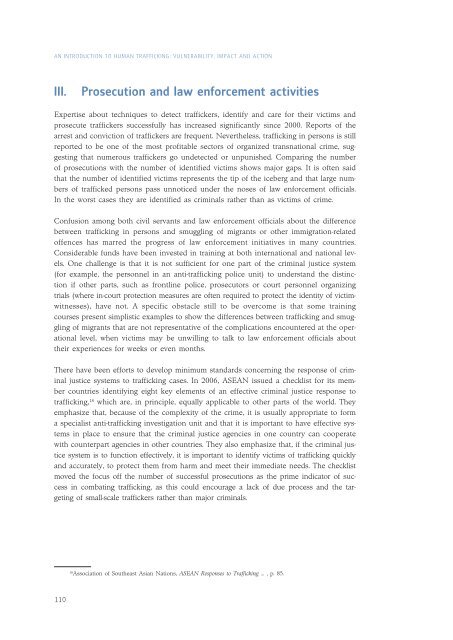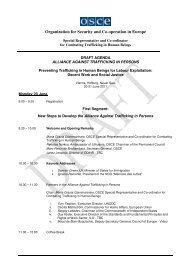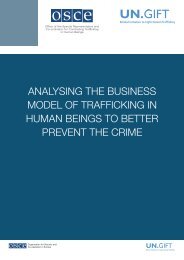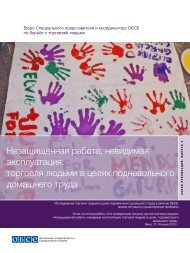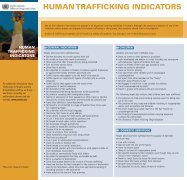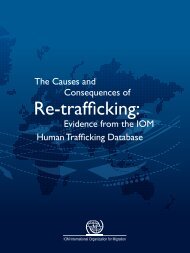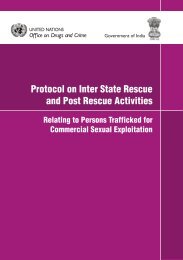An Introduction to Human Trafficking - United Nations Office on ...
An Introduction to Human Trafficking - United Nations Office on ...
An Introduction to Human Trafficking - United Nations Office on ...
Create successful ePaper yourself
Turn your PDF publications into a flip-book with our unique Google optimized e-Paper software.
AN INTRODUCTION TO HUMAN TRAFFICKING: VULNERABILITY, IMPACT AND ACTION<br />
III.<br />
Prosecuti<strong>on</strong> and law enforcement activities<br />
Expertise about techniques <str<strong>on</strong>g>to</str<strong>on</strong>g> detect traffickers, identify and care for their victims and<br />
prosecute traffickers successfully has increased significantly since 2000. Reports of the<br />
arrest and c<strong>on</strong>victi<strong>on</strong> of traffickers are frequent. Nevertheless, trafficking in pers<strong>on</strong>s is still<br />
reported <str<strong>on</strong>g>to</str<strong>on</strong>g> be <strong>on</strong>e of the most profitable sec<str<strong>on</strong>g>to</str<strong>on</strong>g>rs of organized transnati<strong>on</strong>al crime, suggesting<br />
that numerous traffickers go undetected or unpunished. Comparing the number<br />
of prosecuti<strong>on</strong>s with the number of identified victims shows major gaps. It is often said<br />
that the number of identified victims represents the tip of the iceberg and that large numbers<br />
of trafficked pers<strong>on</strong>s pass unnoticed under the noses of law enforcement officials.<br />
In the worst cases they are identified as criminals rather than as victims of crime.<br />
C<strong>on</strong>fusi<strong>on</strong> am<strong>on</strong>g both civil servants and law enforcement officials about the difference<br />
between trafficking in pers<strong>on</strong>s and smuggling of migrants or other immigrati<strong>on</strong>-related<br />
offences has marred the progress of law enforcement initiatives in many countries.<br />
C<strong>on</strong>siderable funds have been invested in training at both internati<strong>on</strong>al and nati<strong>on</strong>al levels.<br />
One challenge is that it is not sufficient for <strong>on</strong>e part of the criminal justice system<br />
(for example, the pers<strong>on</strong>nel in an anti-trafficking police unit) <str<strong>on</strong>g>to</str<strong>on</strong>g> understand the distincti<strong>on</strong><br />
if other parts, such as fr<strong>on</strong>tline police, prosecu<str<strong>on</strong>g>to</str<strong>on</strong>g>rs or court pers<strong>on</strong>nel organizing<br />
trials (where in-court protecti<strong>on</strong> measures are often required <str<strong>on</strong>g>to</str<strong>on</strong>g> protect the identity of victimwitnesses),<br />
have not. A specific obstacle still <str<strong>on</strong>g>to</str<strong>on</strong>g> be overcome is that some training<br />
courses present simplistic examples <str<strong>on</strong>g>to</str<strong>on</strong>g> show the differences between trafficking and smuggling<br />
of migrants that are not representative of the complicati<strong>on</strong>s encountered at the operati<strong>on</strong>al<br />
level, when victims may be unwilling <str<strong>on</strong>g>to</str<strong>on</strong>g> talk <str<strong>on</strong>g>to</str<strong>on</strong>g> law enforcement officials about<br />
their experiences for weeks or even m<strong>on</strong>ths.<br />
There have been efforts <str<strong>on</strong>g>to</str<strong>on</strong>g> develop minimum standards c<strong>on</strong>cerning the resp<strong>on</strong>se of criminal<br />
justice systems <str<strong>on</strong>g>to</str<strong>on</strong>g> trafficking cases. In 2006, ASEAN issued a checklist for its member<br />
countries identifying eight key elements of an effective criminal justice resp<strong>on</strong>se <str<strong>on</strong>g>to</str<strong>on</strong>g><br />
trafficking, 18 which are, in principle, equally applicable <str<strong>on</strong>g>to</str<strong>on</strong>g> other parts of the world. They<br />
emphasize that, because of the complexity of the crime, it is usually appropriate <str<strong>on</strong>g>to</str<strong>on</strong>g> form<br />
a specialist anti-trafficking investigati<strong>on</strong> unit and that it is important <str<strong>on</strong>g>to</str<strong>on</strong>g> have effective systems<br />
in place <str<strong>on</strong>g>to</str<strong>on</strong>g> ensure that the criminal justice agencies in <strong>on</strong>e country can cooperate<br />
with counterpart agencies in other countries. They also emphasize that, if the criminal justice<br />
system is <str<strong>on</strong>g>to</str<strong>on</strong>g> functi<strong>on</strong> effectively, it is important <str<strong>on</strong>g>to</str<strong>on</strong>g> identify victims of trafficking quickly<br />
and accurately, <str<strong>on</strong>g>to</str<strong>on</strong>g> protect them from harm and meet their immediate needs. The checklist<br />
moved the focus off the number of successful prosecuti<strong>on</strong>s as the prime indica<str<strong>on</strong>g>to</str<strong>on</strong>g>r of success<br />
in combating trafficking, as this could encourage a lack of due process and the targeting<br />
of small-scale traffickers rather than major criminals.<br />
18<br />
Associati<strong>on</strong> of Southeast Asian <str<strong>on</strong>g>Nati<strong>on</strong>s</str<strong>on</strong>g>, ASEAN Resp<strong>on</strong>ses <str<strong>on</strong>g>to</str<strong>on</strong>g> <str<strong>on</strong>g>Trafficking</str<strong>on</strong>g> … , p. 85.<br />
110


